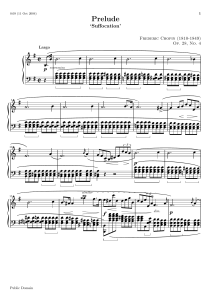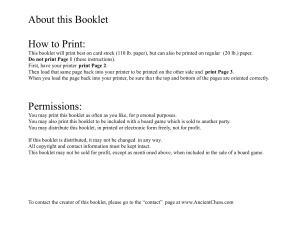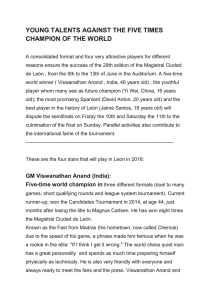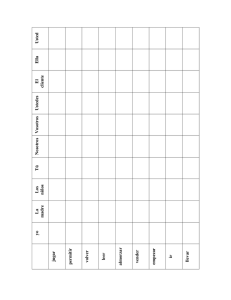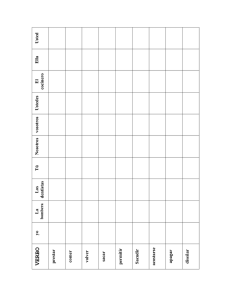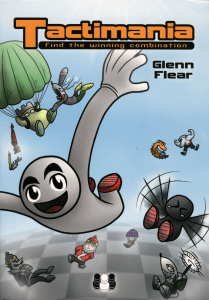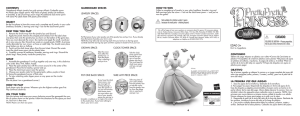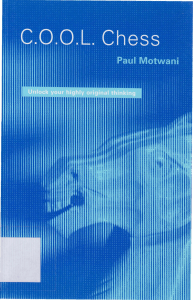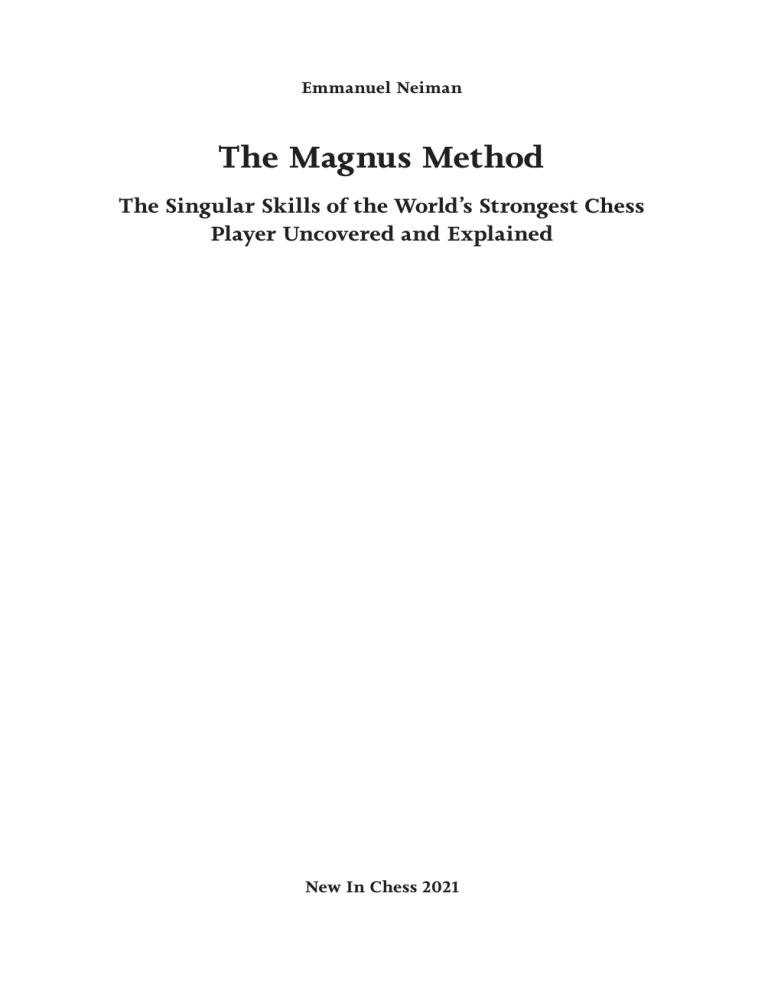
Emmanuel Neiman The Magnus Method The Singular Skills of the World’s Strongest Chess Player Uncovered and Explained New In Chess 2021 Contents Explanation of symbols . . . . . . . . . . . . . . . . . . . . . . . . . . . . . . . . . . . . . . . . . . 6 Foreword . . . . . . . . . . . . . . . . . . . . . . . . . . . . . . . . . . . . . . . . . . . . . . . . . . . . . . . 7 Introduction . . . . . . . . . . . . . . . . . . . . . . . . . . . . . . . . . . . . . . . . . . . . . . . . . . . . 9 Chapter 1 Style: from Karpov to Tal? . . . . . . . . . . . . . . . . . . . . . . . . . . 30 Chapter 2 The opening revolution . . . . . . . . . . . . . . . . . . . . . . . . . . . . 40 Chapter 3 Attack: inviting everyone to the party . . . . . . . . . . . . . . . 44 Chapter 4 Defence: the preventive counter-attack . . . . . . . . . . . . . . 57 Chapter 5 Tactics: ‘les petites combinaisons’ . . . . . . . . . . . . . . . . . . . 62 Chapter 6 Exchanges: Carlsen’s main positional weapon . . . . . . . . 76 Chapter 7 Calculation: keeping a clear mind . . . . . . . . . . . . . . . . . . . 83 Chapter 8 Planning: when knowledge brings vision . . . . . . . . . . . . 90 Chapter 9 Pawns: perfect technique and new tips . . . . . . . . . . . . . . 94 Chapter 10 Pieces: the art of going backwards . . . . . . . . . . . . . . . . . . 102 Chapter 11 Endings: breaking the principles . . . . . . . . . . . . . . . . . . . 113 Chapter 12 How to win against Magnus Carlsen: the hidden defects? . . 118 Chapter 13 Games and solutions . . . . . . . . . . . . . . . . . . . . . . . . . . . . . . 122 Index of names . . . . . . . . . . . . . . . . . . . . . . . . . . . . . . . . . . . . . . . . . . . . . . . 317 Bibliography . . . . . . . . . . . . . . . . . . . . . . . . . . . . . . . . . . . . . . . . . . . . . . . . . . 320 5 Foreword Why another book on Magnus Carlsen? The Norwegian has been the World Champion since 2013, and the undisputed number one in the rating list since 2010. He is probably the most dominant chess champion ever, together with Capablanca, Alekhine and Karpov at their best – with the exception of Kasparov, who stayed at the top for fifteen years (1985-2000). My goal as a trainer is to use Carlsen’s games, especially the areas in which he is exceptional, to enable readers to use them for themselves. I try to answer two questions: 1. What does he bring to the game? 2. What are the specific tools he uses? Carlsen’s technique often seems deceptively simple: when you play through his games, the moves seem obvious – you feel that this is the logical way to go. But more often than not, his opponents, usually the best players in the world (after him), didn’t see them coming! I have divided this book into twelve chapters, each of them dealing with a specific ‘Magnus’ approach to one of the main phases of the game. In each chapter, we start with an explanation of Magnus’ approach to the theme at hand. Next (with the exception of the first two chapters), a series of diagrams is given. These diagrams show positions in which I recommend that you first try to find the required move yourself – what would you play here if you were Carlsen? The solutions are given in Chapter 13 with further explanations. The numbers of the diagrams refer to the game numbers in Chapter 13 and the order of the diagrams within those games respectively, e.g. the number ‘15.2’ means the second diagram in Game 15. After you have decided on your move, look at the solution. The level of difficulty varies, some topics (e.g. calculation, planning and endings) are more demanding than others. Some of the topics are obvious, like tactics, attack, and endings. Others are less common in exercise books, such as pawn play, piece play and exchanges, because Carlsen has introduced new trends, sometimes even new understanding, in these areas. A theme like ‘exchanges’ is clearly 7 The Magnus Method important to all players, but especially in Carlsen’s case we are dealing with one of the basics of his game. I have used computer engines to assist in analysing the games, mainly Stockfish 10, 11 and 12. When a move is considered the best, or is given an exclamation mark, it is usually Stockfish’s first move. This does not mean that it is the absolute best move! The evaluation is an indication, nothing more. You’d be surprised how many changes I noted between the Stockfish 10 and Stockfish 12 evaluations, for example. In any case, Carlsen’s conception of what a good move is depends on several factors. In most cases, it’s the absolute best move. In other cases, he will choose another move because it gives him a better ‘chance’ of getting the result he is playing for. Recent advances in artificial intelligence demonstrate the same approach – the right move is now considered to be the one that gives you the best result according to the statistics. In the age of computers, Carlsen plays in a very human and logical style, and according to the ‘sporting’ demands of the position. I believe that examining his specific abilities is the best way for you to improve, and to understand chess better. I would like to thank some friends, who helped me by giving me precious advices, tips and help: Charles Bonati, Pascal Chomet, Damian Justo, Olivier Renet, Jérôme Solakian-Vaneyll, Aldo Haïk, Stephane Schabanel and Samy Sahraoui – merci les amis! I wish you lots of pleasure and success with this book! Emmanuel Neiman Paris, June 2021 8 Introduction In this introduction, we will briefly discuss two aspects of Magnus Carlsen’s play: his technique and various strong points that are not directly related to technique. Carlsen’s special technique for winning ‘even’ positions The main point with Carlsen is his ability to win equal or very slightly favourable positions. He became World Champion in 2013 thanks to his victory in two totally equal positions in rook endgames (the World Chess Championship Match vs Anand in Chennai 2013, Games 5 and 6). He retained his title in 2016 against Karjakin thanks to his win in Game 10 after a long, technical game. In his win over Caruana, in the rapids of the 2018 World Chess Championship, the first decisive win was in another drawish endgame. How does he do it so consistently, against the best-educated players of all time? In addition to his main qualities, Carlsen has developed a unique technique that has two aspects, one negative and one positive. The negative side: Carlsen, commenting on an online rapid game against Dubov (27.12.2020): ‘I was trying to keep the position alive, obviously, and it felt like there was nothing, nothing, and just suddenly I managed to trick him and get a win. It felt a bit accidental, to be fair, but it’s okay, as long as you can keep it from being a forced draw you can often get something in those games.’ This means that you don’t let your opponent get a game where he knows what to do. An example of this is his game against Caruana, where he doesn’t opt for a 4/3 rook endgame that was famously lost by Anand. His opponent would feel comfortable with the position, even though it is clearly worse, because such endings have now been studied, and a path to the draw could be known. This is part of ‘prophylactic thinking’1, when you should not let the opponent get what he hopes for. In a simplified position, you look for a simple way to get the draw, so Carlsen chooses moves that don’t allow the opponent to get that kind of position, anticipating his wishes and trying to prevent them. He pushes for victory by allowing the game to continue, and as long as there is a game, there are possible mistakes to be made. 1 Dvoretsky explained in his books that you should always consider what the opponent has in mind, even when you develop your own plan. Prophylaxis was originally a purely technical concept from Nimzowitsch, but it is now the way modern players think. As Carlsen has also mentioned another of Dvoretsky’s concept – the superfluous knight – we can safely assume that he appreciates the Russian’s legacy. 9 The Magnus Method Magnus Carlsen Shakhriyar Mamedyarov Shamkir 2014 (1) ._T_._M_ j._.sJj. .j._T_.j _.jRi._I D_I_._._ l._QbN_. I_R_.iI_ _._._.k. 2881 2760 Here Carlsen played 24.♖d6, refusing to force the play with 24.♖d8+, which makes it easier for Black, because otherwise the following moves would be easy. The positive side: ‘He’s a very special player and he manages to create ten times more problems for you than anybody else. I felt like I was holding decently and then it was one of his last tricks that finally worked for me’ – Daniil Dubov, 30.12.2020. Carlsen constantly changes the position. He will go for an attack on the queen’s wing. If the opponent is capable of (or if he feels that the opponent is capable of) countering it, he will go for an assault on the king, and then he will change everything to get a favourable ending. Even in an endgame, he will go through all possible endings, using exchanges, changes in pawn structure, etc., so that he can give the opponent many chances to go wrong. When the opponent is happy to have solved a problem – answering a question, as in an exam – then another, probably very different question will be asked next, and then another, and another... even in a simple position like a rook with two pawns against a rook with one pawn, he will try many piece formations (with two pieces!) to try to confuse the opponent. Some games against Karjakin are typical. There was the important win in the 10th game of the World Championship Match in 2016, and even more so, the thriller played in Wijk aan Zee, 2013. In this game (see the diagram on the next page), Carlsen, having tried everything (opening surprises, middlegame strategy changes, structural modifications, queen exchanges, material imbalances...), reached one of his favourite endgames (a rook and an opposite-coloured bishop each), but was not able to beat his opponent. As a last chance he tried a tactic, a sacrifice of two pawns, that finally worked. 10 Introduction Magnus Carlsen Sergey Karjakin 2861 2780 Here, Carlsen played 67.g4 hxg4 68.h5!?. Wijk aan Zee 2013 (8) ._._Rl._ _._._Jm. ._._._J_ _.j.i._J ._Bj.i.i _._I_.i. ._._.k._ _T_._._. This way of constantly changing the course of the game is a known ploy in bad positions; Carlsen uses it in good positions, a new way of playing to gain an advantage – unlike players like Kramnik or Fischer, who simply tried to outplay their opponents by playing the ‘best’ moves. Playing for victory in such thrillers is completely exhausting, so it is not surprising that Carlsen, even while outplaying his opponents, loses to some of them. The losses against Vachier-Lagrave (2017 Sinquefield Cup), or Caruana (2012 Grand Slam final) were partly due to fatigue, especially against strong and resilient defenders. This way of playing also has consequences for his style. Thanks to this evolution, the maturing Magnus is able to employ all kinds of openings, pawn structures and playing styles, and now often uses his encyclopedic knowledge to change the course of a game, because he wants his opponents to be faced with many different problems to solve. If we take just one game, the Carlsen-Vachier-Lagrave game from the 2015 Gashimov Memorial is the most typical of this singular technique – and also one of his best achievements. The game begins with an opening surprise (4.♘a3), which leads to a virtually unknown position that turns out to be a type of Queen’s Indian Defence, a closed game with some space advantage for White. Here, Carlsen surprisingly decides to ‘lose’ – sacrifice – a pawn in the form of an apparent blunder (14.♗g5!?), a very typical intuitive sacrifice by the Norwegian (as in the 2019 victory over Giri), and forcing the opponent to make a choice: ‘Should I take, or should I refuse the pawn?’. Then, after Vachier-Lagrave’s acceptance, a brief tactical mêlée ensues, followed by a phase of positional play, with White able to find excellent squares for his pieces (instead of regaining the pawn) and gaining a clear advantage. However, surprisingly, while his pieces seem to 11 The Magnus Method be in perfect positions to attack Black’s king, Carlsen decides to exchange queens, to play an endgame with an advantage on the queenside. Again, there is a positional phase, when White’s advantage leads him to win a pawn. When Black decides to sacrifice a piece to counterattack with an advanced protected passed pawn, Carlsen allows his opponent to promote, to force a checkmate with the rook and bishop. So, in one single game, there are lots of surprises, changes of pace, shifts from one side to the other (from the queenside to the centre, then to the kingside, then a few exchanges, back to the queenside, and dropping the queenside pawns to checkmate on the kingside). One can imagine how many different problems the opponent has to solve just to stay in the game. Apart from the necessary calculations, the strategic changes are constant, even if the pawn structure seems fixed in the opening. In this game, we can witness one of Carlsen’s strengths, namely the transition from one phase to another. By transition I mean not only the classical ‘jumps’ between the opening and the middlegame, and between the middlegame and the endgame, but also the change between a tactical and a positional phase and also the problems of exchanging. If we compare this way of playing with Fischer’s, here is an important point: for Fischer, you have to find the best move all the time – there is no real transition and you always have to be perfect! According to Spassky, in an interview with me in 1992, this was Bobby’s only flaw: ‘He didn’t feel the important moments of the game’. On the contrary, this is one of Carlsen’s strengths – as you can see from his thinking time. In the first rapid game of the World Championship Match against Caruana (Game 247), White had a clear advantage both on the board and on the clock before his 24th move. Nonetheless, he used nine of his remaining thirteen minutes to try to find the forced win he thought existed – and indeed it did, but he was unable to find it. Among the best players, one can imagine many of them making a random move, to use the time advantage and hope for a mistake by the opponent. Carlsen’s strong points Here we discuss some of Carlsen’s strengths that are not directly related to technique: 1. Evaluation In any position and at any time, Carlsen is able to assess accurately, and this gives him a huge advantage over his competitors. This is where 12 Introduction Carlsen differs from many of his predecessors. Not so long ago, a touch of optimism was considered to be the mark of great players. Apart from players like Alekhine or Botvinnik, who often bluffed in their written analyses, claiming to have devised long-term plans (both would pretend making long-term plans covering nearly the whole game...), most modern players are of the optimistic variety, with the notable exception of Petrosian (who was often too pessimistic!). Tal of course was, and Karpov is the most remarkable. He always feels like he is winning, not for positional reasons, but because he has great confidence in his own talent. Larsen was most optimistic, and it cost him dearly against Fischer. Fischer and Kasparov were more balanced, but still had a soft spot for ‘their’ position. Topalov is a great optimist – he wants blood and always plays as if he is winning. Kramnik’s subjectivity is phenomenal, and in press conferences you can still hear him explain his games with, ‘I was completely winning, crushing my opponent, when something extraordinary happened...’. Then you look at the game, and the cold assessment of the computer is a constant 0.00. Anand, Magnus’ predecessor, is the first modern World Champion who constantly tries to get an objective assessment of the position before making any decision or plan. But Carlsen has taken this ability to a new level. This way of constantly evaluating and re-evaluating positions is openly shown to everyone in the famous ‘Banter Blitz’ sessions against other strong players or aficionados, when he plays and comments at the same time. Most often, these sessions are played on his co-owned site Chess 24, and you can see the replays on YouTube. It’s fascinating, especially when you compare what he sees and looks for with the thinking of another strong player, as in the six-game match with Svidler (both players comment live; the comparison is impressive). Apart from the humorous commentary, there’s a lot to learn from these blitz sessions. Magnus likes to state old chess truths – he is well-read! – and he doesn’t hesitate to admit his momentary weaknesses, the moves he didn’t see, the calculations he made before taking this or that decision. What is clear is that he is constantly looking for the truth, the best moves, the best possible decision according to the situation, taking into account all factors, the clock times, the score and the opponent. Overall, this ability to objectively evaluate almost every position and situation is probably his greatest talent. I remember a game in London, one of his favourite tournaments that he used to win almost every time. He was playing against an outsider, the Englishman David Howell, and had taken a lot of risks to unbalance the position, boldly sacrificing two pawns for dynamic compensation, which was quite difficult to evaluate. 13 The Magnus Method Magnus Carlsen David Howell 2826 2633 London 2011 (1) ._.tLm._ jRj._Jj. ._Jt.l.j _._.jI_. ._B_N_Q_ d.i._._I I_._._Ik _._._R_. I remember that immediately after finishing this game, Carlsen went straight from the theatre to the public conference room and was asked about the evaluation. After all, here he was two pawns down against an initiative. He said it was all the time very even (before Black’s mistake), which is quite surprising, and is exactly the evaluation offered by today’s computers! About this ability, Kramnik commented in 2020: ‘[Magnus] is by far the best in this. His assessments are so precise and so “cool-blooded”. He never gets emotional... I was always amazed how often he was right, to a millimetre... I haven’t seen a single player who was so precise and so stable.’ This extraordinary ability to assess any type of position is probably the key to Carlsen’s success. He is able to anticipate most situations better than his opponents. Good positional assessment is both proof that his understanding of the 14 game is superior, and the guide that allows him to navigate the complications more effectively, making his calculations easier. Anand once commented on the possibility of cheating with computers during games. You don’t even need the right move, just the evaluation, explained the Indian legend. Then you can understand the importance of Carlsen’s talent in this aspect. 26...♖6d7 26...♕a4 is equal. 27.♕f3 ♕a4 28.♕e2 ♖e7 28...♕a3 was better. ._.tLm._ jRj.tJj. ._J_.l.j _._.jI_. D_B_N_._ _.i._._I I_._Q_Ik _._._R_. 29.♘xf6! gxf6 30.♕e3! ♖ed7 30...♕xc4 31.♕xh6+ ♔g8 32.♖b4; 30...♔g7 31.♖b4 ♕a5 32.♖f3 ♔h7 33.♗e2 e4 34.♖f4. ._.tLm._ jRjT_J_. ._J_.j.j _._.jI_. D_B_._._ _.i.q._I I_._._Ik _._._R_. 31.♕c5+! ♖d6 Introduction 31...♔g7 32.♖f3 (32.♖b4) 32...♖d6 33.♖g3+ ♔f8 34.♖xc7. 32.♖xc7 ♕c2 33.♖c8 ♖8d7 34.♗e6 ♔e7 35.♗xd7 ♗xd7 36.♖h8 ♕d3 37.♖f3 ♕d5 38.♕xa7 e4 39.♕b8 ♕e5+ 40.♖g3 Black resigned. Being able to know the evaluation of the position is crucial in many positions. The most crucial situations occur in defence. In these cases, it makes a huge difference whether you are slightly worse, clearly worse, or lost – to mention just three cases – and there are many more nuances. Let’s look at two positions: Vladimir Kramnik Garry Kasparov 2770 2849 London 2000 (4) ._L_.m._ _._SlJj. JjT_J_S_ _._._.i. ._._Ii._ _N_.bN_. Ii._B_._ _._R_.k. White has a spatial advantage, while Black’s position, though solid, is slightly passive. Kasparov hated this kind of position, and on more than one occasion showed himself unable to hold them. 25...♖c2 This is a very bold counterattack. In itself the move is not a blunder, but it is a rather strange move to play if you know the evaluation (+0.20 approximately). With all his pieces passively placed, Kasparov intends to counterattack with his only active piece – not the move a ‘positional’ player like Karpov or... Carlsen would seriously consider. Yet it is perfectly viable according to the computer. After a passive move like 25...♖c7, the position is equal. Then, Black will replace the bishop on b7 and wait. The careful 25...♔e8, to defend the d7-knight, is also very good. 26.♗xa6! ♗xa6 27.♖xd7 Now Black is in danger. ._._.m._ _._RlJj. Lj._J_S_ _._._.i. ._._Ii._ _N_.bN_. IiT_._._ _._._.k. Apparently, White is in the lead after this tactical operation. Yet a stricter evaluation of the position would allow Black to find resources. 27...♖xb2 was played in the game, leading to a losing position. Except for the rook, Black’s pieces are passive and unable to join the attack. Kramnik played accurately at first, only 15 The Magnus Method to spoil the victory later in the game. After 27...♔e8 28.♖a7 ♖e2!, Black sacrifices a second pawn but manages to activate all his pieces. It is interesting to note that Kramnik, in his recent and great videos ‘Vladimir Kramnik rasskazhivaet o legendarnom matche c Garry Kasparovim! Interview tretye’ on YouTube, does not mention this possibility and regards 27...♖xb2 as practically forced. 27...♖e2 first works too. way! The rook is trapped forever!’ exclaimed Yasser Seirawan, the live commentator. But since the game is already lost, what difference does it make? The mistake becomes more plausible when we realize that Black had only two minutes left to play and was the underdog of the tournament on the Elo scale. After the ‘normal’ 30...a4 31.♗f2 ♔f8 32.♗h4, then f5-f6, and Black is crushed. 31.a3 What is your assessment of the second position, with Black to play? .t._._._ _.j.m.j. ._Jl._Ij j.j.jI_I T_I_K_._ i._.b._. .iRr._._ _._._._. Samuel Sevian Timur Gareyev 2642 2557 St Louis 2019 (4) .t._._._ _.j.m.j. ._Jl._Ij j.j.jI_I .tI_K_._ _._.b._. IiRr._._ _._._._. Black has one more pawn, but the accurate assessment is that his position is hopeless. Black was able to evaluate correctly, and thus played for an exceptional trick, of which Carlsen would certainly have been proud: 30...♖a4 This is a fantastic attempt to swindle the opponent. ‘♖a4? No 16 31...♖b3 This is the real trick. I checked the video on YouTube, and when 31...♖b3 was played, Sevian carefully took his pen, wrote the move in a very composed way, looked at the board and, after a second, played: 32.♖d3 ._._._._ _.j.m.j. ._Jl._Ij j.j.jI_I T_I_K_._ iT_Rb._. .iR_._._ _._._._. Introduction Of course, this is a very natural and technical move. Since the rook on a4 is dead, it makes sense to exchange the last active enemy piece, right? In a blitz game, most GMs would instantly play 32.♖d3. Yet, with 14 minutes to play, a suspicious player would have wondered why an experienced fighter and strong GM like Gareyev would suddenly play stupid, nonsensical moves like 30...♖a4, allowing his rook to be trapped, or 31...♖b3, exchanging his only valuable piece. 32...♖xb2! After 33.f6+ (the main variation goes 33.♖xb2 ♖xc4+ 34.♔f3 e4+) White was hardly able to achieve a draw. 2. Chess knowledge Carlsen’s chess culture is enormous, and he knows practically everything about chess, having learned it mainly from books. Great games, famous players, openings, pawn structures, endings... he has studied everything and remembers it! Like Kasparov, he is said to have a great photographic memory. He is an exception because many players of his generation have been mainly influenced by computers, and this general chess culture has helped him on some occasions, like when he encounters a strange pawn structure, or a rare middlegame theme. Of course, it is of the utmost importance in technical phases, like in openings or endgames. Teimour Radjabov Magnus Carlsen 2784 2835 Moscow 2012 (5) ._._._.t _.j._._. .mJjL_._ _J_.j.j. ._._I_._ i.iB_Ik. .i._._I_ _.r._._. 35...c5! This is the right plan, just like the great Capablanca played in exactly the same pawn structure (see below). One of Carlsen’s secrets is his incredible erudition, although he would have been able to find the plan without knowing the game. His understanding of any pawn structure, especially rare ones like in this game, is unparalleled, past or present. 36.♖a1 c4 37.♗c2 ♔c5 38.♖e1 c6 39.♗b1 ♔b6 40.♗c2 ♔c7 41.♔f2 ♔d7 42.a4 bxa4 43.♖a1 ♖b8 44.♖a2 d5 45.exd5 cxd5 46.♗xa4+ ♔d6 47.♗c2 d4 48.♗e4 ♖b6 49.♔e2 g4 50.fxg4 ♗xg4+ 51.♔d2 ♗e6 52.♔c2 ♗d5 53.♗xd5 d3+ 54.♔d2 ♔xd5 55.♔e3 ♖g6 56.♖a5+ ♔e6 57.♔e4 ♖g4+ 58.♔f3 ♖f4+ 59.♔e3 ♖f1 White resigned. 17 The Magnus Method CHAPTER 6 Exchanges: Carlsen’s main positional weapon Exchanges are one of the main weapons in the arsenal of any chess player for many reasons – defensive reasons (exchanging queens, for example), attacking purposes like exchanging the opponent’s fianchetto bishop, or the f6-/f3-knight that defends the castled king. In the endgame, the choice of the right exchange is crucial to get the desired result. In the opening, it may be important to exchange an opponent’s active piece. Carlsen’s exchanges deal with all these points, but the Norwegian exchanges for another reason: he likes to change the position as often as possible, and an exchange is a way for him to confront his opponents with new problems, apart from the objective advantage of the transaction. When Carlsen fails to gain an advantage with a certain set of material, he provokes exchanges so that there are different problems to be solved. A classic example is his 2020 victory over Firouzja in the pawn endgame, after trying many different endings. In the following diagrams, you must decide whether a possible exchange is favourable or not. The diagram numbers refer to the order within the games as they are given in Chapter 13, e.g. ‘3.2’ refers to the second diagram in Game 3. 3.2 ._Mt._.t jJj.l._J ._._.j._ _._J_.j. ._Si._._ _.n._.i. Ii._Ii.i r.bR_.k. 76 4.1 .t.t._M_ jL_DsJlJ .jSjJ_J_ _.j._._. QiI_Ni._ i._.i.i. .b.iN_Bi _R_._Rk. The Magnus Method CHAPTER 9 Pawns: perfect technique and new tips Pawn technique is not an area that is thoroughly studied in chess. There are some experts, notably Botvinnik, Petrosian and Karpov, who have developed concepts of how to play with pawns in this or that structure (for example, the Spassky-Petrosian World Championship Match 1966, the Torre Attack). Carlsen is the pawn expert par excellence, and he knows all the tricks (see the rapid games with black against Karjakin and Topalov) and even teaches us new ones, like his famous rook pawn pushes, some of them with sacrifice (see his game as Black against Aronian, Tarrasch Defence). The difference between most of Karpov’s games – which often aim at maintaining a superior structure – and Carlsen’s pawn play is that the Norwegian’s style is more active and he often plays aggressive pawn moves, with the intention of dismantling the opponent’s position. Carlsen’s favourite technique is a pawn sacrifice played to free a square or a line (for example, ...e5-e4 in the famous rapid game in the playoff for the world title against Karjakin). More recently, attacking moves like the f2-f4 sacrifice against Giri, giving up a pawn with check and ruining the structure to gain access to the g-file, became an important part of his arsenal. In the following diagrams, you are asked to find a strong pawn move. The diagram numbers refer to the order within the games as they are given in Chapter 13, e.g. ‘3.4’ refers to the fourth diagram in Game 3. 3.4 ._M_T_.t jJj._._. ._._.j._ _._J_SjJ I_.i._._ _Ir._.i. .b._Ii.i r._._K_. 94 3.5 ._M_T_.t jJ_._._. ._J_.j._ _._J_S_J I_.i._J_ _Ir._Ii. .b._I_.i _.r._K_. CHAPTER 11 Endings: breaking the principles GM Miguel Illescas wrote in 2013 (about Carlsen playing equal positions): ‘Rules have exceptions and this kid has specialized in detecting them’. It is remarkable that Carlsen, arguably the best endgame player of all time, frequently goes against the generally accepted principles of the endgame, though he knows many of them. There are a few typical points that might be emphasized. The propensity to deliberately choose an opposite-coloured bishops ending, when other endings are possible. This is for example the case in the famous 2011 game against Nakamura (Game 38). Most players would have dismissed this ending because of its known drawish tendencies, but Carlsen often went for it and played it successfully in most cases. The choice of the queen and bishop versus queen and knight endgame is another. Classical theoreticians (in chess this means old Russian coaches!) have considered that the association of the queen with the knight is most often an advantage over the queen + bishop pair. Dorfman, when he sees such a fight, thinks that the player who has queen + knight has a ‘material advantage’. Kramnik, commenting live on Chess 24, recently acknowledged the ‘rule’. Carlsen apparently disagrees, and willingly plays with the queen + bishop duo for a win, with much success, aside from a win with black against McShane in 2012, in his encounters with Jobava (Game 58), Leko (Game 59) and Ni Hua (Introduction), games in which he provokes exchanges that lead to such endings. Incidentally, Carlsen clearly stated (in a recent Banter Blitz session) that in his view the bishop is stronger than the knight, so that if you can take a bishop without any immediate negative consequences, you should do so – in line with Tarrasch, who felt that the difference between bishop and knight was comparable to (though less important than) the difference between a minor piece and a rook (the ‘small exchange’). The choice of playing with a queen against two rooks is also a frequent guest in his games – perhaps it is a kind of stylistic bias. The modern (= computer) evaluation is that the queen is worth nine pawns, while two rooks are worth ten pawns. In endgames with symmetrical structures, the advantage of two rooks is often greater, because they are able to attack a single pawn twice. Nevertheless, there are cases where the queen is superior (chances of attacking the king, dangerous passed pawn, poor rook 113 The Magnus Method coordination), and Carlsen aims to ‘specialize in such positions’, although it should be noted that on the whole his record is not as good as usual with this balance of material (see Game 241). As always, the diagram numbers refer to the order within the games as they are given in Chapter 13, e.g. ‘1.1’ refers to the first diagram in Game 1. 1.1 ._.m._._ _J_._J_. ._J_J_.j _.i._J_. JiI_._._ i._._Ki. ._._.i.i _._._._. 18.1 ._._._._ _._._._. .jK_.mJ_ l.j._J_. I_B_.i.i _I_._.i. ._._._._ _._._._. 22.1 ._._._._ _.j._J_. J_.m._J_ _._._._J .iLn._.i i._.kI_. ._._._I_ _._._._. 114 15.2 ._._._._ _._M_._. ._._.b.i _._.i._. Jk._._._ i._._._. ._L_._._ _._._._. 19.1 ._._.m._ _J_._JjJ ._._.s._ jNtJ_.s. I_._._._ _I_._Ii. ._Ir.kBi _._._._. 23.1 R_._._._ i._._Jm. ._.j._J_ _._._.i. ._._Ii.j t._._._. ._.k._._ _._._._. The Magnus Method The finish is perfect. 39...♔d7 40.d6 ♖b7 41.e5 fxe5 42.♖xe5 ♖e8 43.♖e7+ ♖xe7 44.dxe7 ♖c7 45.♖d1+ 1-0 Game 3 Bjorn Erik Glenne Magnus Carlsen 2235 2163 Oslo 2002 (1) ._Mt._.t jJj.l._J ._._.j._ _._J_.j. ._.iS_._ _._.b.i. Ii._Ii.i rN_R_.k. 16...♘d6! This is an excellent square for the knight in this pawn structure. Magnus rightly wants to prevent it from being exchanged. 16...c6 was also good, intending, if 17.♘c3, 17...♘d6. 17.♘c3 ♘c4 17...c6 18.♖ac1 ♔d7!? is a computer suggestion. 18.♗c1 ._Mt._.t jJj.l._J ._._.j._ _._J_.j. ._Si._._ _.n._.i. Ii._Ii.i r.bR_.k. 124 18...♗b4! Carlsen looks for an ending with a strong knight against a not so good bishop. He often tries to get this asymmetrical duel (knight against bishop or bishop against knight) to get more winning chances. 19.♖d3 ♗xc3 19...c6. 20.♖xc3 ♖de8 21.b3 ♘d6 22.♔f1 ._M_T_.t jJj._._J ._.s.j._ _._J_.j. ._.i._._ _Ir._.i. I_._Ii.i r.b._K_. 22...h5 23.a4 ♘f5 24.♗b2? 24.♖a2!, and if 24...♘xd4, 25.♖d2, was equal. ._M_T_.t jJj._._. ._._.j._ _._J_SjJ I_.i._._ _Ir._.i. .b._Ii.i r._._K_. 24...g4! This is an excellent positional decision. The pawn move is important and is the only one that secures a large advantage for the second player. If you want to open the h-file, you have to fix the enemy pawn. This still allows you Chapter 13 – Games and solutions to keep the enemy rook away from the f3-square, and to secure the position of the knight on f5. On 24...h4?, 25.g4! keeps the h-file closed. 25.♖ac1 c6 26.f3 ._M_T_.t jJ_._._. ._J_.j._ _._J_S_J I_.i._J_ _Ir._Ii. .b._I_.i _.r._K_. 26...h4! 27.e4 If 27.fxg4, the simplest is 27...♘e3+ 28.♔g1 (on 28.♔e1, ._M_T_.t jJ_._._. ._J_.j._ _._J_._. I_.i._Ij _Ir.s.i. .b._I_.i _.r.k._. analysis diagram 28...h3!, followed by the capture of the g4- and h2-pawns with the knight) 28...hxg3 29.hxg3 ♘xg4, and Black doubles on the h-file with a winning attack. 27...hxg3 28.hxg3 ♘xd4 29.fxg4 ♖xe4 30.♖d3 ♖h1+ 31.♔g2 ♖xc1 32.♗xc1 ♖xg4 33.♗e3 c5 34.♗xd4 ♖xd4 35.♖xd4 cxd4 36.♔f2 ♔d7 37.♔e2 ♔d6 38.b4 ♔e5 39.♔d3 f5 0-1 Game 4 Espen Lie Magnus Carlsen 2260 2385 Fredrikstad ch-NOR 2003 (6) .t.t._M_ jL_DsJlJ .jSjJ_J_ _.j._._. QiI_Ni._ i._.i.i. .b.iN_Bi _R_._Rk. 14...♘d4! 15.♕d1 ♘xe2+ 16.♕xe2 ♗xe4 17.♗xe4 ♗xb2 18.♖xb2 The rules on how to fix pawns in minor piece endings are well studied in chess literature, as far as bishops are involved. In the struggle between two bishops of the same colour, there is only one rule, with very few exceptions: place your pawns on the opposite colour of your bishop, and try to force the opponent to play his pawns on the colour of his own bishop. With bishops of opposite colours, the player playing for the win must place his pawns on a different colour than his bishop, while the side playing for the draw must place the pawns on the same colour as his bishop. When a knight is fighting a bishop, there are two methods. One, the more aggressive one, is to place his protected pawns on the bishop’s colour, so that he can block him; the other, the more solid one, is to place his pawns on the opposite 125 The Magnus Method sixth rank – see the game against Mamedyarov. A forced variation would have won a pawn with a great advantage: 29.♘c6 ♘b4 30.♘xb4 ♖xb4 31.♖d7 (inserting 31.♖c6!? now is interesting) 31...♖e7 32.♖c8+ ♔f7 33.♖xe7+ ♔xe7 34.♖c7+. After 34...♔e6, White has the choice between the two rook pawns, both with a very favourable, but not clearly won, ending. 29...♔g7 30.♘b5 ♖4e7 31.♖dd6 ♘c5 32.♘c7 ♖f8 ._._.t._ j.n.t.mJ .jRr.jJ_ _.s._._. ._._._I_ _._.iK_I I_._.i._ _._._._. 33.h4! Keeping it complicated! This spacegaining move is excellent. 33.♖xc5 bxc5 34.♘e6+ is also playable, but more easy to play for the opponent. 33...♖ff7 34.♘d5 ♖d7 35.♖xd7 ♘xd7 36.♔g3 ♘c5 37.f3! h6 38.♘f4 g5 39.♘h5+ ♔g6 40.f4 gxf4+ 40...♘e4+ 41.♔f3 ♖e7 42.♖e6!. 41.exf4 ♔h7 42.f5 ♔g8 43.♔f3 ♘d7 44.♔e4 ♔f8 45.♖c8+ ♔e7 46.♔d5 b5 47.♖h8 ♘b6+ 48.♔c6 ♘c4 49.♖a8 ♘e5+ 50.♔c5 ♘d7+ 51.♔xb5 ♔d6 52.♖xa7 ♖f8 53.♔b4 ♘c5 54.♔c4 1-0 134 Game 18 Magnus Carlsen Yannick Pelletier 2775 2569 Biel 2008 (1) ._._._._ _._._._. .jK_.mJ_ l.j._J_. I_B_.i.i _I_._.i. ._._._._ _._._._. 55.♗d3! The idea is to attack f5. 55...♔f7 56.h5 gxh5 57.♗xf5 ♔f6 58.♗e4 ♔g7 59.♗f3 ♔h6 60.♔b5 ♔g6 61.♗d1 ♔h6 62.♗e2 ♔g6 63.♗f3 ♔h6 64.♗c6 1-0 After 64...♔g6 65.♗e8+ ♔h6 66.♗f7, another pawn is going to fall. Game 19 Magnus Carlsen Teimour Radjabov Cap d’Agde 2008 (6) ._._.m._ _J_._JjJ ._._.s._ jNtJ_.s. I_._._._ _I_._Ii. ._Ir.kBi _._._._. 2786 2751 Chapter 13 – Games and solutions 37.♖e2! This is an important theme in the endgame. We know that the rook is worth five pawns, and a bishop and knight three, although these are values for the whole game. In many cases, the knight’s value decreases in the endgame – except in some cases, when Magnus uses them! The king is a very powerful piece in the endgame and the only one apart from the queen to control all the squares around him. The estimated value of a king is four pawns. So in many endgames, it is a major point to be able to activate our king and to keep the opponent’s king passive. This is the meaning of White’s move, cutting off Black’s king before activating his own. This is not a Magnus speciality, just good technique. But it’s relevant to see how often, against top players, Magnus’ king is active all over the board, while his opponent’s king stays in place, trying to defend a few pawns; this game is no exception. 37...♘e6 38.♗h3 ♘g5 39.♗f5 g6 40.h4 ♘xf3 41.♔xf3 gxf5 42.♘d4 ._._.m._ _J_._J_J ._._.s._ j.tJ_J_. I_.n._.i _I_._Ki. ._I_R_._ _._._._. As usual, all of Carlsen’s pieces are perfectly placed. The next step is to bring the king deeper into the opponent’s position and try to swallow up some enemy queenside pawns. 42...♔g7 43.♘xf5+ ♔g6 44.♘e7+ ♔g7 45.g4 h6 46.♔f4 h5 47.gxh5 ♘xh5+ 48.♔e5 b6 49.♖d2 f6+ 50.♔d6 d4 51.♘d5 d3 52.c4 ♖c8 53.♖xd3 f5 54.♔e5 f4 ._T_._._ _._._.m. .j._._._ j._Nk._S I_I_.j.i _I_R_._. ._._._._ _._._._. 55.♘xf4! White falls for the trick and allows a small combination that wins a knight but loses the game. The active king is no match for the opponent’s poorly-placed pieces. Magnus loves to sacrifice a knight in the endgame, because he anticipates positions where the proud horse is just worth a pawn, as it has to be sacrificed against a lone passer. 55...♖e8+ 56.♘e6+ ♖xe6+ 57.♔xe6 ♘f4+ 58.♔d6 ♘xd3 59.♔c6 ♘c5 60.♔xb6 ♘xb3 61.c5 1-0 If 61...♔f7 62.c6 ♔e7 63.c7 ♔d7 64.h5, and a new queen is going to appear. 135 The Magnus Method Game 20 Magnus Carlsen Alexander Grischuk 2776 2733 Linares 2009 (12) .t._TlM_ _J_._JjJ Ji.i.s._ _.n._._. ._._J_._ _._._._. .iI_BrIi _._R_._K favourite Andre Agassi, the loser said about the winner: ‘He is cool like a cucumber.’ This could apply to 18-year-old Magnus, playing the cold, and only, winning move. 36...♗xb2 37.d7 1-0 Game 21 Alexander McDonnell Louis Charles De Labourdonnais Match London 1834 (16) ._.l._Tm _._I_.jJ ._._._._ j._._._. ._._._._ _.q._._. Ii.jJjIi _._R_._K 28.♖xf6! gxf6 29.♘d7 Attacking both rooks, as 30.♘xf6+ and 31.♘xe8 is a possible threat. 29...f5 30.c4 a5 31.c5 ♗g7 32.♘xb8 ♖xb8 .t._._M_ _J_._JlJ .i.i._._ j.i._J_. ._._J_._ _._._._. .i._B_Ii _._R_._K 33.♗a6! ♗f6 If 33...bxa6 34.d7 ♗f6 35.c6 ♖xb6, 36.c7 is simple and good. 34.♗xb7! ♖xb7 35.c6 A nice ‘coup de chapeau’ to La Bourdonnais! Magnus knows his classics, and enjoys paying tribute to his glorious predecessors. 35...♖xb6 36.♖c1! In tennis, when the young Pete Sampras appeared in a semi-final of the US Open and destroyed the 136 0-1 Game 22 Magnus Carlsen Dmitrij Jakovenko 2772 2760 Dortmund 2009 (1) ._._._._ _.j._J_. J_.m._J_ _._._._J .iLn._.i i._.kI_. ._._._I_ _._._._. 36.g4! hxg4 Allowing White to get a potential outside passed pawn on the h-file is Chapter 13 – Games and solutions no fun, but the alternative, letting the opponent create a weak h-pawn blocked on the ‘bad’ colour, is worse: If 36...♔e5, 37.gxh5 gxh5 38.f4+ ♔f6, preventing ♘g7xh5. Here this is a kind of mutual zugzwang, as both White’s knight and Black’s king must keep the crucial f5-square under control: 39.a4 A) If 39...♗f1, 40.♔f3! wins (40.♔e4 ♗g2+) after 40...♔g6 41.a5 ♔f6 42.b5 ♗c4 43.♔e4 ♔g6 (43...♔e7 44.♘f5+ ♔d7 45.bxa6 ♗xa6 46.♘g3) 44.b6; B) 39...♗d5 40.♔d3 ♔g6 41.a5 ♔f6 ._._._._ _.j._J_. J_._.m._ i._L_._J .i.n.i.i _._K_._. ._._._._ _._._._. analysis diagram 42.♘c2!. Thanks to a tactical trick, White manages to replace the knight on e3 to keep control of f5 and allow the white king to invade the queenside via d4 and c5. The game is over because b4-b5 will create a passed pawn. 37.fxg4 ♔e5 Once again, in the ‘money time’, five moves before the time control, Carlsen’s opponent has to take a crucial decision, requiring deep calculation, with very probably little time left on the clock. It is important for Magnus to be able to play quickly, so that the pressure he exerts through the strength of his moves can be increased by the opponent’s time pressure and fatigue after three to four hours of play. Sixty years ago, people didn’t calculate as much, relying more on positional or tactical intuition. Nowadays, a strong GM spends most of his time calculating variations, which can be exhausting. Magnus himself, who calculates a lot, sometimes seems very tired just after just a few rounds in a strong tournament. Jakovenko had to calculate the following line: 37...c5! (it is clearly an achievement to get rid of this weakness, the problem being that the defensive king looks very far removed from the h-pawn) 38.bxc5+ ♔xc5 39.h5 gxh5 40.gxh5 f6 41.h6 ♗g8 (this is clearly forced, but White looks able to win the bishop) 42.♘e6+ ♔d6! 43.♘f8 ♔e7 44.h7 ♗xh7 45.♘xh7 ♔f7 46.a4 ♔g7 47.♘xf6 ♔xf6 48.♔d4 ♔e6 with a draw. 38.♘c6+ ♔f6 39.♔f4 ♔e6 40.h5 gxh5 41.gxh5 ♗d3 42.♔e3 ♗f1 43.h6 ♔f6 44.♘e5 ♗b5 45.♔d4 ♗a4 ._._._._ _.j._J_. J_._.m.i _._.n._. Li.k._._ i._._._. ._._._._ _._._._. 137 The Magnus Method 46.h7! The main problem in a dominant position is how to finish off the opponent. Every player knows the situation: you enjoy a positional superiority, make the most of your pieces, force the opponent’s pieces into passive squares and everything is fine! But then you have to finish the game and to strike. This is the dangerous moment when you risk losing your advantage – sometimes even worse – in trying to convert a so-called ‘winning position’. Some players (like Karpov and Petrosian) prefer to wait for the opponent’s mistake and sometimes strike too late. Others like to strike quickly, even too early and before having made all the preliminary preparations (put your pieces in the best possible positions and the opponent’s in the worst before striking). Here we could mention Topalov and Kasparov. In this regard, Carlsen is close to perfection. He hits as soon as possible – being naturally aggressive and direct – but is able to wait for the right moment to execute a tactic he has noticed. The only player I can compare him to, as a perfect striker, is Bobby Fischer. 46...♔g7 47.♘xf7 ♔xh7 48.♘g5+ ♔g6 49.♘e6 1-0 Both pawns will be attacked and taken by the king and the knight, so the endgame is an easy win. 138 Game 23 Magnus Carlsen Levon Aronian 2813 2782 Nice rapid 2010 (2) R_._._._ i._._Jm. ._.j._J_ _._._.i. ._._Ii.j t._._._. ._.k._._ _._._._. 52.♔e2! Carlsen simply brings back the king to take the h-pawn, after which the execution is smooth. 52.♔e1! also works. 52...h3 53.♔f2 ♖a2+ 54.♔g1 ♖g2+ 55.♔h1 ♖a2 56.f5 ♔h7 57.f6 h2 58.♖f8 ♖xa7 59.♔xh2 ♖b7 60.♔g3 ♖a7 61.♔f4 ♖b7 62.♔e3 ♖a7 63.♔d4 ♖c7 64.♖e8 ♖a7 65.♔d5 ♖a5+ 66.♔xd6 ♖a6+ 67.♔e7 ♖a7+ 68.♔f8 1-0 Game 24 Ruslan Ponomariov Magnus Carlsen Nice rapid 2010 (10) ._._._M_ _._.jJ_J ._T_._J_ r._.i._. ._._._._ _._._._I ._._.iIk _._._._. 2737 2813
